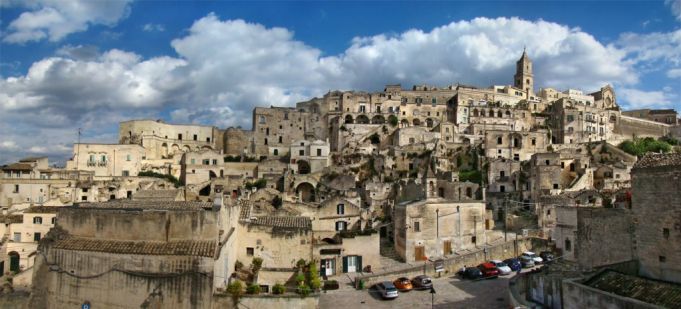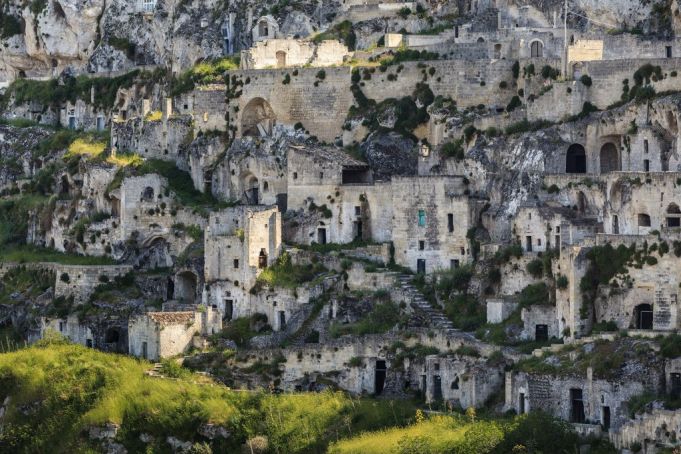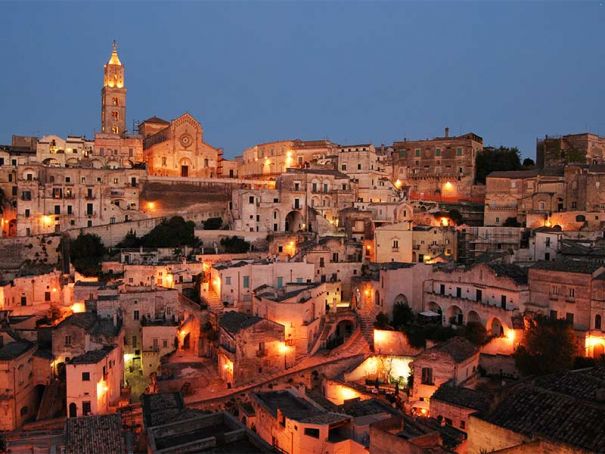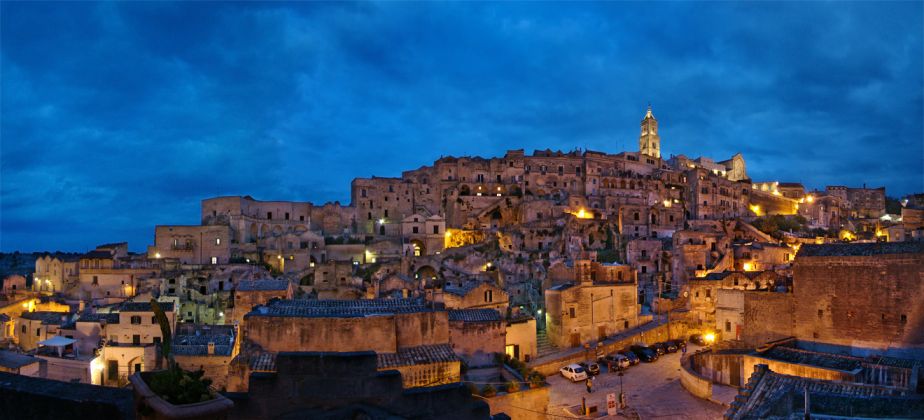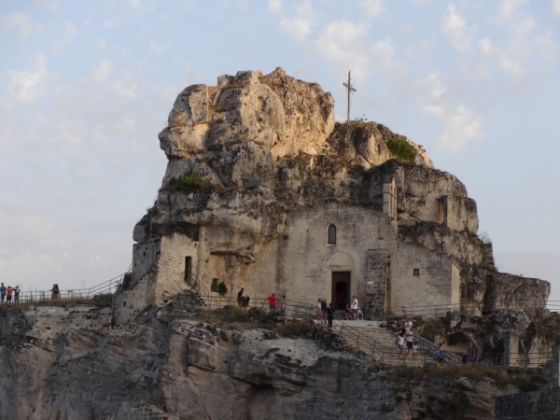Once the shame of Italy, Matera is now the pride of Europe.
The city of Matera, former capital of the Basilicata region in southern Italy known for its sassi or cave dwellings, has recently received much-deserved recognition with its designation as European Culture Capital for 2019.
Over the past 20 years Matera has experienced the most dramatic and impressive urban renewal since Florence’s Renaissance. While Matera is one of the oldest cities in the world with evidence of continual habitation cut from the rocks since the palaeolithic times, the golden years for the city began in the baroque period because its man-made caves provided optimal conditions for leather, cheese, wine and olive oil production.
At that time, it was one of the wealthiest parts of southern Italy and the capital of the Basilicata region until 1806. Later, the cave districts that had once provided so much wealth for the city sank into extreme poverty and at the turn of the 20th century were symbols of dismal poverty and used as spartan living quarters for farmers lacking running water. In the 1950s they were completely closed off and abandoned.
This impressive and densely populated town, perpetually inhabited and modified for thousands of years, with its stunning rock-carved mediaeval churches and prehistoric homes and mills all built into the soft limestone, it was not accessible from 1950-1993. The inhabitants were forced into government housing projects and the community disintegrated.
In Carlo Levi’s 1945 memoir, Christ stopped at Eboli, adapted into a 1970s film, the sassi are described as dark holes riddled with filth and disease. Since their grand re-opening in the 1990s many luxurious baroque palaces and churches in the sassi district have been renovated and modified for modern use, creating one of most fascinating tourist attractions in the world. Sleeping and dining in the caves is now an exotic experience.
One local resident, Francesco Foschino, is particularly likely to benefit from the rise in tourism expected from the city’s selection as European Capital of Culture. All four of his grandparents used to live in the sassi and in the 1950s three of them lost their properties as they accepted free housing from the government. None of them ever went back to the old town and they stopped speaking the local dialect. One of his grandparents however did keep his property and after decades of abandon he has turned the cave dwelling into a luxury hotel called Palazzo degli Abati.
Foschino works as a tour guide and takes visitors to discover the many hidden layers in the caves. On a steep walk through the sassi he takes you on top of what amounts to about 10 storeys of buildings that were excavated directly out of the rock. He explains that these caves are all man-made and that no materials were brought in to construct the various chambers inside. The depth of the caves proves that for hundreds of years the community had been making inventive use of the ecosystem and terrain of the Murgia valley.
Unlike Rome, where layers of history are buried under one another, the Matera strata go deep into the caves which are built on top of each other. Inside a hotel, further back one finds a modern house, and a mediaeval church that later became an oil mill. Staircases are carved on roofs of houses and houses open deep into performing arts centres and water cisterns below. There is even a golf course constructed in the caves under a hotel, and on the roof of one building is a cemetery.
Particular highlights in the city are the many rupestrian churches carved into the rock, such as the church of S. Maria de Idris with well-preserved mediaeval and renaissance fresco paintings on the walls. It is part of a complex of two churches located on Monterrone, a spur of rock that rises in the Sasso Caveoso.
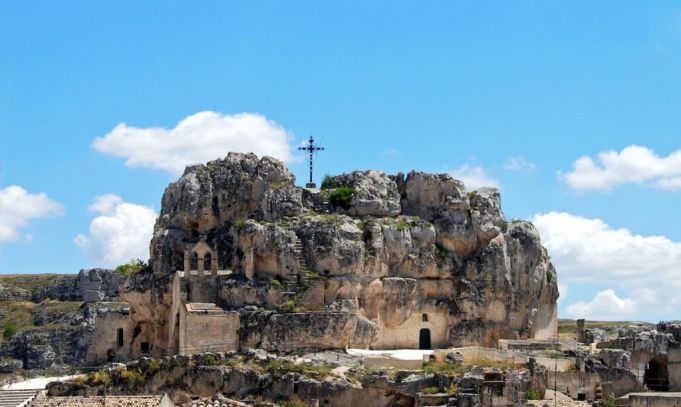
In Piazza del Duomo there is a 15th-century palace, recently transformed into a hotel called Palazzo Gattini, that had belonged to a count. Like all families who lived in the rock-hewn buildings, the family was forced to leave. The historic palace was abandoned for decades and opened as a luxury hotel five years ago. The interior design – blending clean and modern with natural stone and baroque architecture – emphasises the diverse layers of the city’s history and is a microcosm of Matera’s potential.
The palace has been sumptuously renovated, and guest rooms are converted from the music room, the library or the family chapel, and an elaborate breakfast is hosted in the old wine and cheese cellar. The hotel offers a unique way to discover the sassi the way the baroque nobles of the city once did.
Matera overcame tough competition for the title of European Culture Capital 2019 and was chosen from a pre-selection process that included over 20 Italian contenders such as Aosta, Bergamo, Cagliari, Caserta, Erice, Grosseto-Maremma, L’Aquila, Lecce, Mantova, Palermo, Perugia, Pisa, Ravenna, Siena, Siracusa, Urbino and Venice.
Androulla Vassiliou, the European commissioner responsible for culture, stated: "The competition for the title in Italy was one of the strongest ever, with 21 initial contenders narrowed down to six finalists. I am confident that Matera will attract more visitors from Europe and all over the world to discover the city, its history and the cultural diversity which is one of strengths of our continent. I am convinced that the title will bring Matera and its surrounding area significant long-term cultural, economic and social benefits, as we have seen with previous European Capitals of Culture."
Matera was chosen in part for its unique “anthropological” dimension. Since the region of Basilicata spreads from the Tyrrhenian to the Adriatic, Matera and its region have always been territories of passage, exchange and transformation. The area was a crossroads for Magna Grecia and Rome, for Byzantium, Arabia and north to Swabia. Moreover the city's rehabilitation of the sassi is one of the most important examples of urban regeneration in the Mediterranean.
Foschino believes the city was chosen because it is living proof that another kind of culture is possible, a culture made by common people for common people and not just by great artists for the elite. He also says the local people are proud of the recognition for the history and achievements of the town after having once been named the "shame of Italy". The first step was being declared a Unesco World Heritage Site in 1993, followed now by the title of European Capital of Culture.
The aim of the European Commission is to foster the regeneration of Matera as part of its overall goal to highlight the richness and diversity of cultures in Europe, to regenerate and raise the international profile of cities, and to boost tourism.
Theresa Potenza
This article first appeared in the 14 January 2015 edition of Wanted in Rome.



